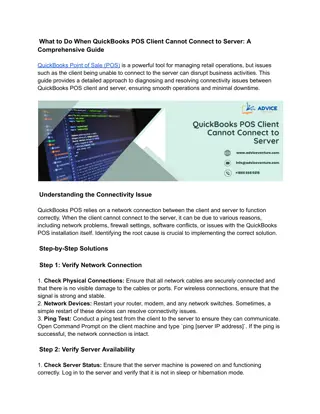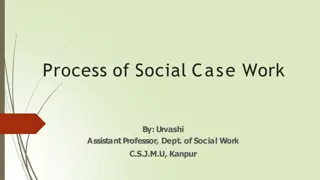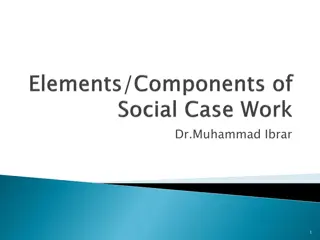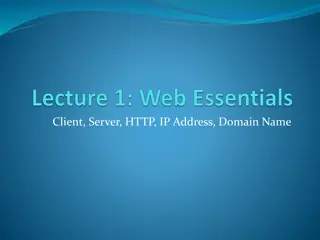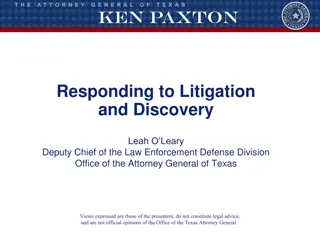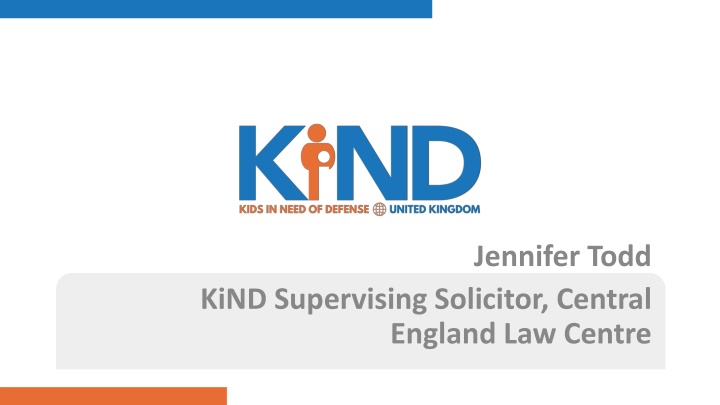
Key Tips for Communicating with Vulnerable Clients in Legal Settings
Learn how to effectively communicate with vulnerable clients in legal settings, including understanding their backgrounds, building trust, and overcoming language barriers. Gain insights on managing clients with mental health or SEN issues, and navigate challenges related to undocumented or temporary status. Discover practical advice for interacting with scared or nervous clients who may have had negative experiences with the immigration system.
Download Presentation

Please find below an Image/Link to download the presentation.
The content on the website is provided AS IS for your information and personal use only. It may not be sold, licensed, or shared on other websites without obtaining consent from the author. If you encounter any issues during the download, it is possible that the publisher has removed the file from their server.
You are allowed to download the files provided on this website for personal or commercial use, subject to the condition that they are used lawfully. All files are the property of their respective owners.
The content on the website is provided AS IS for your information and personal use only. It may not be sold, licensed, or shared on other websites without obtaining consent from the author.
E N D
Presentation Transcript
Jennifer Todd KiND Supervising Solicitor, Central England Law Centre
Communicating with Clients Communicating with Clients We ll cover: Knowing your KiND client group Ground rules Building trust + rapport Language and interpreters Team roles 2
Kinds client group Kind s client group Consider: Vulnerability potentially, due to background. Isolated. How and when did they enter the UK; for what purpose; economic migrant / failed asylum seeker / Domestic Violence / Victim of Trafficking, or perhaps have never presented to the authorities. Mental health + SEN issues present. How manage? Supervisor can help. Undocumented (potentially)/ temporary status - Inability to trust or trust with ease. Particularly to those in position of authority, i.e: you. Current socio-economic situation if undocumented, or with temporary status, likely low income, poor housing conditions. Impact on Fee Waiver process- slow disclosure. Impact on taking instructions- private space, wifi, lap top etc. 4
Client group Client group Scared / nervous when meeting you. They may be uncomfortable communicating with people in positions of authority May find zoom / lots of faces on screen overwhelming. Unfamiliar with City law firms and your role English may not be their first language They may be very worried about their situation, or embarrassed about how they are living/having overstayed their visas. They may have received negative decisions from authorities. They may have had previous poor experiences of lawyers and the immigration system 5
Who is the client? For KYC/file management purposes, client is the child or young person who is making the application to the Home Office But who you take instructions from may be different Older teens v younger kids Parent, foster carer, social work or other type of guardian Be mindful of background and fact one/both parents may not be involved 6
Children Children 7
Ground rules Ground rules Representing children + vulnerable adults requires a particular skill set: training, consideration of + planning a case, and practice. It is balancing your legal practise with your human skills. Ensuring confidentiality + client s understanding of this. Explain that you are acting in their best interests. This is central to your work; reinforce that throughout your time acting. Explain that you are independent from the Home Office and will not share data / contact the Home Office without the client s permission Time: building trust and rapport can take time. 8
Clients needs Client s needs Friendly, professional + non judgemental approach Clear communication / jargon free Check in with clients around their understanding Responsive and regular contact or confirmed contact as and when In person appointment consider particularly if drafting Witness Statement Use of interpreters where needed (please don t rely on children to translate) Manage expectations with regular communication and provision of time frames Prompt action + communicate work done demonstrate you re engaged and prioritising applications. E:g: instructions letter- 2 weeks after sign up. Once submitted give realistic time frames for decision and set out your check ins. 10
Prepare well for your first meeting Prepare well for your first meeting Main aim is to establish a rapport and create a safe space that will allow you to take instructions. Make it clear that the children are your client Can be overwhelming for client - particularly if remote. Long wait to get here! Make it clear that you have read the documents and are familiar with their circumstances Be realistic about what you can achieve at first meeting intros, summarise facts and advise on law and policy where appropriate Make a simple plan for future action Explain clearly who you are, and what you are aiming for Make a commitment to speak to the parent again on/by a specified date- eg: KYC processes Use simple language and avoid legal jargon Check during the meeting that the client is understanding you. Remember they may be willing to please. 11
Communication Communication Key to building trust and rapport is clear and regular communication in a way the client needs it to be - ask the client initially, and as you progress the matter what they would prefer Email and Zoom is not always best due to literacy or language issues. Call clients or invite them into the office. Cold calling is ok and often quicker than arranging to call. Equally be aware of college/ school hours/ jobs. However younger clients, or those born in UK, may be fine with Zoom/email, or may prefer Whatsapp. Whatsapp / text: Easy to use google translate if needed. Ease of sending PDFs. If sending docs in post for signing, send a SAE. *Online submission- copies fine. If requesting docs to copy- courier. 13
Changes to ease client comfort Changes to ease client comfort Online or over phone: If meeting on Teams/Zoom, check that they are in a confidential, quiet place Check if the family have wi-fi or need to use costly data to attend remote appointments Do they have the tech needed to meet you? On-line is preferable but can also phone if that works better Make sure everyone on the call is on camera if possible* In-person: Arrange appointments that allow clients to avoid travel at peak times to reduce cost Arrange appointments that allow parents to collect their children from school/older kids to attend school Offer a pre-paid Oyster card/travel ticket or data packages if you are able Offer lunch if an in-person meeting coincides with a meal time 14
Difficult clients, or those struggling to engage Difficult clients, or those struggling to engage If you find that you are having problems with your client s ability to respond or engage, then talk to your supervisor. It is usually not your fault. It s likely to be anxiety, trauma, stress, mental health issues, SEN issues, immigration, financial or housing issues -etc. Do they need extra support? If so: referral to other services. Speak to me/supervisor re what services available. Regular communication helps e.g.: weekly text and informal check-ins Make a plan with client explain their responsibilities and yours; your time frame for submission. Manage expectations; be realistic for both you and client. 15
Using interpreters A whole other skill set! SS should have identified language needs before you meet client, but not always possible (can check during 1stmeeting) Kind can fund this (or firm can) Brief interpreter in advance if possible Check client and interpreter understand each other at the start Remember conversation is between you and the client, not the client and interpreter (if you think this is happening, remind interpreter of their duties) Use short sentences don t overload the interpreter! 16
Team work 17
Team work Team work Consider splitting your team in 2 for the Fee Waiver and separate Citizenship application. Who is main contact for each. Inform client. Think about the skills you have as a team- particular area suited to skill-set? Tech Interpersonal (especially with younger people and vulnerable parents) Financial/budgeting Research Legal Drafting Witness statements Organisation Evidence gathering 18
Team work Team work Consider setting up an internal weekly / fortnightly team call Same time Same day of the week Same agenda set and led by senior lawyer / the person leading on matter Keep it short and effective Senior team members / experienced FE s lead use your existing structures and make them work for you E.g: Partner / senior lawyer copied in to all emails / correspondence Please keep your KiND supervisor updated! 19
Tips Avoid jargon and check in with clients that they understand Always ask supervisor if you re not sure Even if they don t sound like they appreciate you acting for them in a Pro Bono capacity, they do! Despite the differences in background, clients are just normal people. We all have the interpersonal skills to handle issues raised. 20
Resources Free Movement blog - New course: how to work with interpreters effectively - Free Movement EIN best practice guide chapter on interpreters - Interpretation at the hearing | Electronic Immigration Network (ein.org.uk) ILPA vicarious trauma resources - Vicarious Trauma - ILPA Trauma Informed Code of Conduct (TICC) | Helen Bamber 21
Questions? 22
Thank you! Thank you! rebeccaf@islingtonlaw.org.uk www.kidsinneedofdefense.org.uk 23


